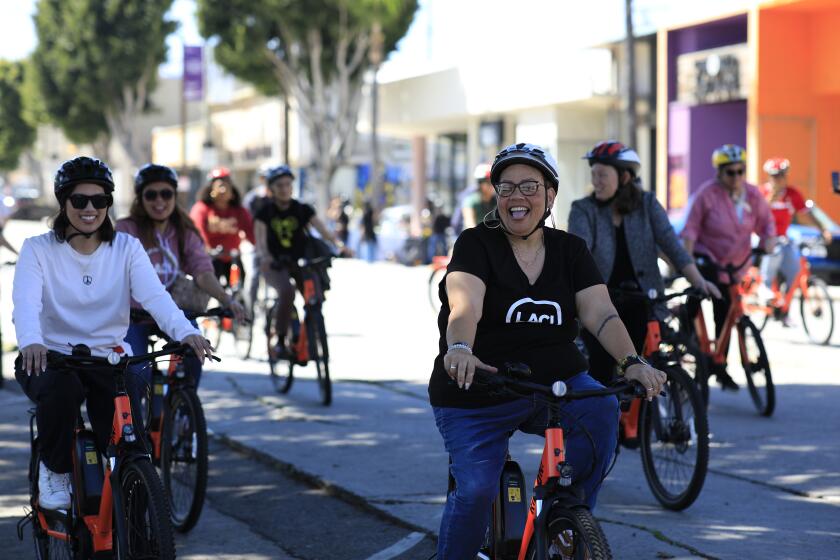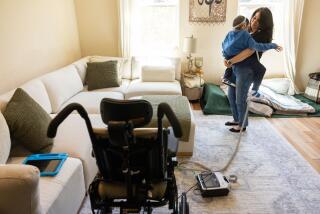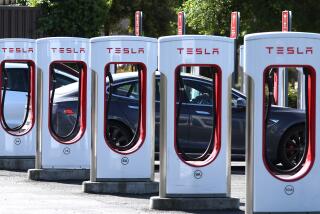California e-bike voucher program flooded with almost 100,000 applications in just 45 minutes

- Share via
- The California Air Resources Board said vouchers for its E-Bike Incentive Project are temporarily unavailable after applicants flooded the agency with requests, leaving some disappointed with the process.
Californians still hoping to nab a state voucher to help pay for an e-bike this holiday season were met instead with seven unwelcome words: “We are no longer accepting incentive applications.”
That’s the message the California Air Resources Board had on its E-Bike Incentive Project webpage as of Friday after residents flooded the agency with applications, leaving some disappointed and frustrated by the process.
The program began accepting online applications at 6 p.m. on Wednesday. Within 45 minutes, the application window was closed after nearly 100,000 applications were submitted, according to the air resources board.
Some applicants complained they were unable to log on mere minutes after that window opened. Some posted screenshots on social media of estimated wait times exceeding an hour.
Others said the application process froze or produced error messages.
Lys Mendez, the board’s communications director, said a fully staffed team handled the application process, which included testing the website and checking for technical issues.
Eligible Californians can apply for up to $2,000 for the purchase of an e-bike, thanks for a state incentive program.
She said problems could have arisen from people using multiple devices under one IP address or not properly refreshing the website, or if their browsers were outdated.
“We were also staffing a helpline, and people who followed our advice on the above after speaking with the representative reported being able to get into the queue,” Mendez said.
The air resources board says additional application windows will be announced in the coming days.
Mendez said the board would apply lessons learned from this launch to future application opportunities.
“The first round of the launch points to an incredible demand for alternative forms of transportation and a willingness to use cleaner mobility options,” Mendez said.
In announcing the program, the air resources board said vouchers would be available to provide as much as $2,000 toward the purchase of an e-bike — a bicycle that includes an on-board electric motor to help make pedaling easier.
The Los Angeles Cleantech Incubator and L.A.’s Department of Transportation, aided by nearly $3 million in funding from the California Air Resources Board, debuted their 250-unit e-bike “lending library” Tuesday at Leimert Park’s Ride On! Bike Co-Op.
The board previously said the program would begin with $3 million, with the goal of providing vouchers for the purchase of 1,500 e-bikes.
The goal is to lower the cost barrier for residents, hopefully reducing car trips and, ultimately, greenhouse gas emissions.
E-bikes vary in price. On average, they’re about $2,000, though some models can cost upward of $6,000, according to outdoor recreational retailer REI. Consumers should avoid extremely low-priced electric bikes, which can be lower quality, according to Consumer Reports.
“By using e-bikes, people can get around and meet everyday needs while improving air quality,” Steven Cliff, the air resources board’s executive officer, said in a statement in early December. “Prioritizing equity and access is key as we work to achieve our zero-emissions goals, and this incentive program will support those efforts by helping e-bikes be part of the solution.”
Applications were open to California residents 18 years and older with an annual household income at or below 300% of the federal poverty level. For example, a single-person household would have to make no more than about $45,000 per year and a two-member household no more than $61,000 to qualify.
Applicants whose income was at or below 225% of the federal poverty level received priority on the application list, according to the air resources board. That translated into a single-family household making no more than about $33,000 and a two-member household income of no more than $45,000.
More to Read
Sign up for Essential California
The most important California stories and recommendations in your inbox every morning.
You may occasionally receive promotional content from the Los Angeles Times.














